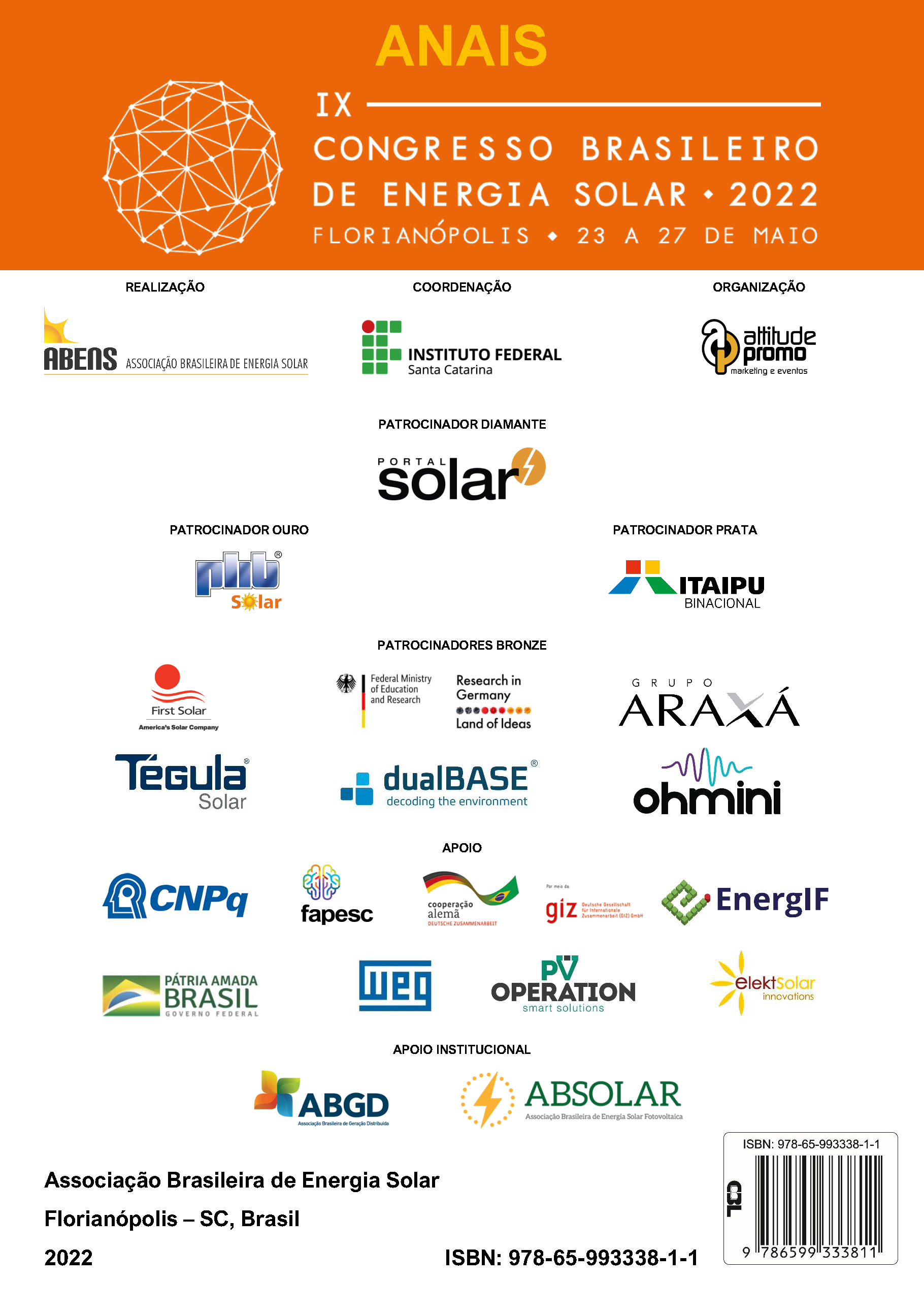MODEL FOR ESTIMATION OF PLANE OF ARRAY IRRADIANCE USING GLOBAL HORIZONTAL IRRADIANCE DATA
DOI:
https://doi.org/10.59627/cbens.2022.1087Keywords:
Transposition Model, Global Horizontal Irradiance (GHI), Plane of Array Irradiance (GT)Abstract
Solar irradiation is the primary source of energy used in photovoltaic systems to generate electrical energy. Thus, the photovoltaic performance is directly affected due to the variation of this meteorological factor. To estimate the energy production of a photovoltaic system, it is essential to consider the solar irradiance data for the location where it will be installed. However, these data usually refer to measurements done by pyranometers (or other measuring instrument) installed in a horizontal position, disregarding the effects of inclination as determined for the installation of photovoltaic modules (locations with latitude > 0º). In this scenario, this work aims to estimate the plane of array irradiance from horizontal global irradiance data. For this, global horizontal irradiance data measured by a meteorological station installed at GREEN/PUC Minas in Belo Horizonte/MG (Equatorial Tropical: 19.92° S, 43.99° W) and another in the test area of the Federal University of Santa Catarina in Brotas de Macaúbas/BA (Semi-Arid: 12.00° S, 42.63° W) were used as input data for the mathematical model, and the results were compared with plane of array irradiance measured oriented to the Solar North and with an inclination equal to the latitude of the respective locations. The comparative results showed that the estimate of the plane of array irradiance is close to the measurement, with differences ranging from -27 to 43% for the city of Belo Horizonte/MG and from -8 to 8% for the city of Brotas of Mcaúbas/BA. The biggest differences were registered in the autumn and winter seasons (lower solar altitude), with the average difference for the entire period evaluated around 4.42% for the city of Belo Horizonte/MG and -0.44% for Brotas de Macaúbas/BA. The comparison, between the solar irradiance measured by the meteorological station and that measured by the photovoltaic cell (inclined), indicated a higher difference, around 6%.
Downloads
References
Burger, S.; Witmer, L.; Brownson, J.R.S. Irradiance modeling variance on vertical plane of array surfaces. 42nd American Solar Energy Society Meeting, Maryland, 2013.
Duffie, J.A.; Beckman, W.A. Solar engineering of thermal processes. 3 ed. New York: John Wiley & Sons, 2006.
Gueymard, C. A. Direct and indirect uncertainties in the prediction of tilted irradiance for solar engineering applications. Solar Energy, vol. 83, pp. 432-444, 2009.
Lave, M.; Hayes, W.; Pohl, A.; Hansen, C. W. Evaluation of global horizontal irradiance to plane of array irradiance models at locations across the United States. IEEE Journal of Photovoltaics, vol. 5, pp. 597-606.
Li, D. H. W.; Cheung, G. H. W.; Lam, J. C. Analysis of the operational performance and efficiency characteristic for photovoltaic system in Hong Kong. Energy Conversion and Management, v. 46, p. 1107 – 1118, 2005.
Maxell, E.L. A Quasi-Physical Model for Converting Hourly Global Horizontal to Direct Normal Insolation. Technical Report No. SERI/TR-215-3087, Golden, Solar Energy Research Institute, 1987.
Sandia National Laboratories. PVPerformance Modeling Collaborative (PVPMC). Disponível
em:<https://pvpmc.sandia.gov/>. Acessado em: 07 dez. 2021.
Soto, W.; Klein, S. A.; Beckman, W. A. Improvement and validation of a model for a photovoltaic array performance. Solar Energy, v. 80, p. 78 – 88, 2006.
Toledo, C.; Amillo, A. M. G.; Bardizza, G.; Abad, J.; Urbina, A. Evaluation of solar radiation tranposition models for passive energy management and building integrated photovoltaics. Energies, vol. 13, 2020.
Zorrilla-Casanova, J.; Piliougine, M.; Carretero, J.; Bernaola, P.; Carpena, P.; Mora-López, L.; Sidrach-de-Cardona, M. Analysis of dust losses in photovoltaic modules. World Renewable Energy Congress, Sweden, 2011.


